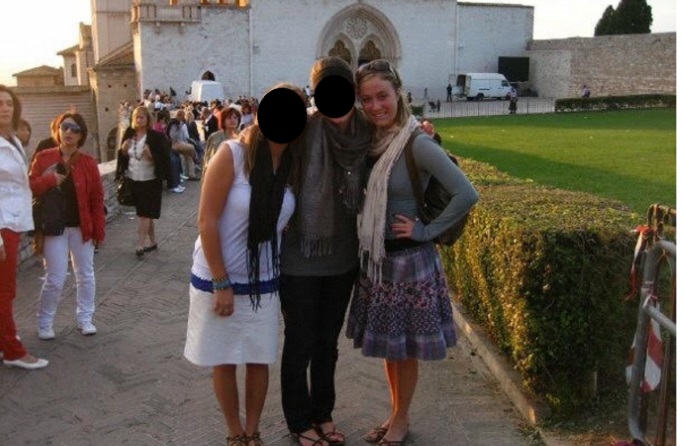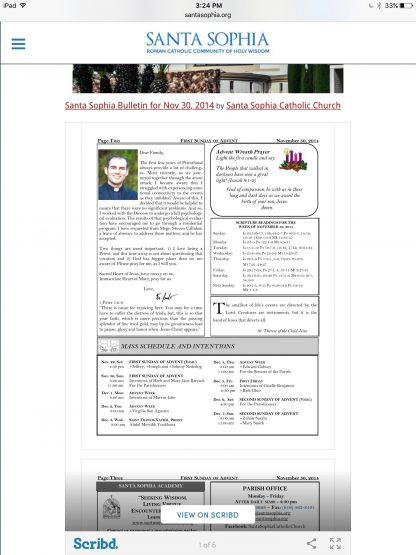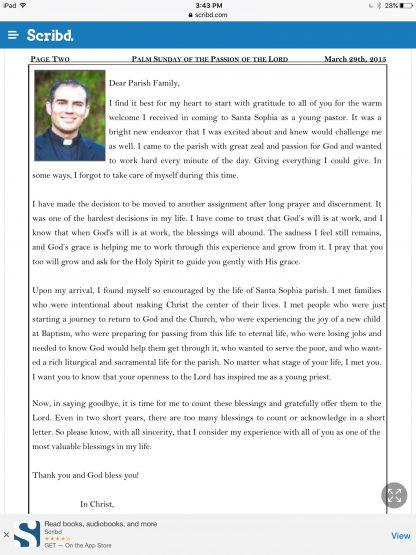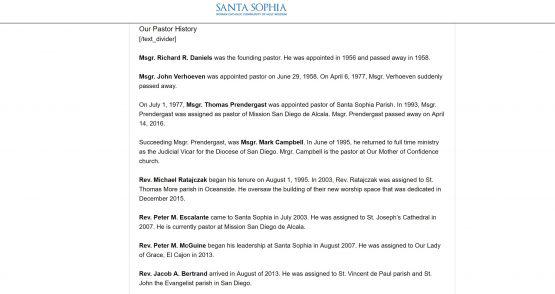|
Lay woman’s saga illustrates clerical sexual abuse of adults
By Elise Harris
Although most attention amid the clerical sexual abuse crisis has been on minors, recent cases of priests and bishops who have taken advantage of vulnerable adults or those under their guidance also have come to light. One such case involves Theodore McCarrick, the 88-year-old retired Archbishop of Washington and Newark who resigned his post in the College of Cardinals following “credible and substantiated” accusations of sexual abuse of minors and multiple accounts of sexual misconduct with seminarians. A second example is a recent report by the Associated Press detailing accounts of religious sisters and nuns who have either been sexually assaulted or raped by priests or bishops, and who have chosen to speak out as part of what has been dubbed the Church’s own “#MeToo” movement.In addition to these sisters, a nun in India also recently accused a bishop of rape, charging that other members of Church hierarchy in the country, such as Cardinal George Alencherry, head of the Syro-Malabar Church in India, knew about it and did nothing. Yet another example, only now coming to light, is the case of Rachel Mastrogiacomo, who, at age 24, was raped in Satanic cult-like fashion by a Catholic priest as he celebrated a private Mass for the two of them. And, she says, when she came forward to the Church, they covered it up. Currently pursuing a lifelong goal of serving as a lay missionary in Africa alongside her husband and recently adopted daughter, Mastrogiacomo’s dream comes at the end of a nightmare that began in 2009 when she was a 23-year-old studying theology in Rome, and which culminated in May with her rapist pleading guilty to criminal charges of sexual assault. Mastrogiacomo spoke to Crux about her experience. The Diocese of San Diego, which handled the canonical dimension of her case, did not respond immediately to a request for comment. An old trauma opens the door to fresh woundsMastrogiacomo said she grew up in a deeply pious Catholic family. As a child she had an especially close relationship with her father, who attended daily Mass. In many ways, she said, her relationship with her father was the foundation of everything to which she would later aspire, including her faith life and her desire to be a missionary. In 1999, when she was 13, her father died after suffering a massive heart attack while working out at the gym, leaving a void that she would eventually seek to fill through the spiritual fatherhood offered by priests around her. “My dad was my world,” Mastrogiacomo told Crux. “This loss rocked me to the core and left me overwhelmed by the thought of navigating the rest of my life without his guidance.” Explaining that her father had died shortly after a “monumental moment” in her life, in which he had taken her to the ocean and told her that the secret to finding joy even amid life’s sorrows is a relationship with the Holy Spirit, Mastrogiacomo said she became heavily involved in Church activities, attending youth groups or catechesis multiple times a week, and was surrounded by “marvelous and trustworthy” priests. After graduating high school, she decided to pursue studies in theology at Franciscan University in Steubenville, Ohio, where she met a man she described as a “holy priest” who offered her “the best of the best” spiritual guidance. After that experience, Mastrogiacomo said she left the university “thinking I could trust all priests in the way I had trusted a saint.” “In my pursuit of holiness, I fell into the trap that is clericalism,” she said. Describing herself as “naïve” at the time, she said that she put priests on “pedestals,” and saw them “as pure and infallible vessels, princely middlemen between myself and the most high God.” Mastrogiacomo said she now understands that alongside this power differential comes “a whole lot of room for abuse,” adding that “respecting the office of the priesthood is one thing; clerical chauvinism, on the other hand, is a disease inside the body of the Church.” It wasn’t until she came to Rome in 2009, she said, to pursue graduate studies in spirituality at the University of St. Thomas Aquinas, also called the “Angelicum,” that she began to experience how this power differential can turn bad. “Brainwashed”After arriving in Rome, Mastrogiacomo met several seminarians studying at the Pontifical North American College (NAC), among them a fourth-year student, by then already a deacon, by the name of Jacob Bertrand. The two became friends, and Bertrand would jest that they were like the biblical pair of Jacob and Rachel, a couple who married quickly after falling in love and gave birth to 12 sons who would later form the 12 tribes of Israel. In one of their first conversations, Mastrogiacomo said Bertrand told her he felt “called” to share his sexual past with her and recounted intimate details of previous relationships before entering the seminary. At the time, Mastrogiacomo said, the conversation didn’t raise any red flags, as she assumed it was an invitation to reflect on the Church’s teaching on chastity since she was a virgin and he was pursuing a vocation to the celibate priesthood. Bertrand also gave her two of his personal journals to read, saying he felt that God was asking him to do so. Mastrogiacomo said that although she did not want to read the journals, she felt compelled to appease Bertrand. Around this time, she began speaking with a new spiritual director, whom she referred to as “Father Tom,” who told her she was “mystically pregnant” and would eventually be the foundress of something that would be of great benefit for the Church. He also confessed to finding her attractive in a “non-distorted” way, and said she had a gift that would help priests to be stronger. Though puzzled by what she was told, since the concept of “mystical pregnancy” is not found anywhere in Church tradition, Mastrogiacomo - who was fascinated by the Church’s concept of mysticism - said she trusted her spiritual director and believed he was leading her down the right path, where her vocation would soon “be born.” However, after a few months she began to feel misunderstood and pressured to become a nun, despite her strong desire to get married, so she stopped speaking with Father Tom and contemplated leaving Rome altogether. She confided this to Bertrand, who convinced her to stay and offered to be her new spiritual director. Mastrogiacomo eventually agreed, and in January 2010 began meeting Bertrand on a weekly basis for “holy conversation.” He also developed a strong relationship with her family, and, aware of Mastrogiacomo’s interest in mysticism, told her that they had a special, pure spiritual bond in which she was like the Virgin Mary and he was like Saint Joseph, her “most chaste spouse.” At one point, he asked for her own personal journal, saying it would help him to know and guide her better in the pursuit of her vocation. Though she didn’t want to give it to him, Mastrogiacomo said that she again trusted her spiritual guide and handed him the book, in which she had written about her desire to get married and her hopes that she might meet her future husband during her time studying abroad. A few weeks later Bertrand told her he believed that he was “the one” she was supposed to meet, and that God was calling her to a mystical union. Shortly after, he took her to a chapel inside the Jesuit-run Gesu parish in Rome, where he made a “spiritual proposal” by holding her hand and asking her to trust him. Though something she said she couldn’t fully describe felt off, Mastrogiacomo said that by that time she had grown to trust Bertrand unquestioningly, and assumed she was supposed to be a type of “spiritual mother” who would help accompany him to his ordination to the priesthood. It was during this time, she said, that Bertrand began to subtly introduce physical touch and sexuality during their meetings, saying it was all “in the name of God.” He had an in-depth background of St. John Paul II’s teachings on the “Theology of the Body,” she said, explaining that his knowledge and articulation of this teaching made what he said convincing. Shortly after their “spiritual proposal,” in one of their weekly conversations Bertrand told Mastrogiacomo that he had a sensual vision of the two of them during prayer, which he said had been “imprinted” on his mind by the Holy Spirit. Mastrogiacomo said that by this point, she had been “completely brainwashed” and believed his vision came from God. So after discussing the vision and determining that it was a sign, she and Bertrand began speaking about when a “mystical marriage” between them could take place. In June of that year Mastrogiacomo flew with Bertrand to San Diego for his priestly ordination. The flight was arranged by Bertrand after speaking with Mastrogiacomo’s mother, who didn’t want her daughter to travel alone. After the ordination, Mastrogiacomo returned home to Minnesota, where another mutual friend was being ordained. Bertrand later joined her there for the ordination and arranged to stay at her family home, as he had developed a very close relationship with her family, particularly her mother. Mastrogiacomo said at the time she had become convinced that she and Bertrand had a spiritual connection that transcended human boundaries, so when the newly-minted priest arrived naked to a private Mass he offered for the two of them in her family’s cabin and expected her to do the same, she trusted him, assuming it was part of fulfilling the spiritual union God was calling them to. “To turn back at that point would have felt like I was turning my back on God,” she said. Any resistance, in her mind, was akin to “demonstrating doubt rather than faith.” It was during the Mass, she told Crux, that Bertrand sexually assaulted her while celebrating the liturgy. However, Bertrand said afterward that he did not think they had completely fulfilled God’s will, so a few days later he offered another Mass in which he assaulted Mastrogiacomo again as part of the liturgy, calling it “the second holiest sacrifice next to Jesus and Mary on Calvary.” After the second Mass, Bertrand said the “mystical union” between he and Mastrogiacomo was something others would not understand, so they had to keep it secret, and he pushed her to continue celebrating their spiritual union with more such “Masses.” Mastrogiacomo said that while still convinced she had acted in obedience to God, she was confused as to why more “Masses” were necessary if their union had already been fulfilled. When she told Bertrand that she believed they had already fulfilled God’s will, he was upset, she said, but agreed after some discussion to respect her wishes and refrain. Bertrand then moved back to San Diego to begin his official ministry as a priest for the diocese, and Mastrogiacomo continued her studies. At one point, he sent her a check for $1,000 as “tithing money” for a graduate course she wanted to enroll in, and the two moved on with their lives. Scales fallSpeaking over a spotty Skype connection from the basement of her home, Mastrogiacomo couldn’t look into the screen to make eye contact as she recounted the abuse. “For years, my psyche simply could not handle reality. I lived an overly religious life and practiced my faith with unprecedented zeal, but I was psychologically trapped in what now seems to have been a robotic kind of state,” she said. It was about a year and a half later when Mastrogiacomo really began to question what had happened. At that point, she said, she started to struggle with anxiety and had doubts about what Bertrand had done to her, wondering if it was sinful. After bumping into him at a celebration for a mutual friend, she expressed her concerns. Not only did his response further validate her doubts, but she said Bertrand laid his hands on her head and prayed for her, comparing her to the Virgin Mary. In a phone conversation that happened shortly after, he again swore her to secrecy, saying “the devil tempts me to think that you will tell somebody and ruin my ministry.” After that experience, and after promising to stay silent, Mastrogiacomo said she became increasingly confused about her vocation and began to spiral after approaching several religious communities, only to experience more fog than clarity. She said her crisis eventually became unbearable during a trip to St. Louis in April 2012, where she was visiting the religious sisters of the Missionaries of Charity order founded by St. Theresa of Calcutta, which she was contemplating joining. She broke her silence a month later, nearly two years after the assault, telling a close friend the full story and how she was struggling to understand what to make of what happened, and what she was being asked in terms of vocation. Though at first she agonized over the thought that opening up would result in the loss of her relationship with God, the moment everything came to light, “it felt like scales were falling from my eyes.” “I experienced a taste of mortification and horror beyond my ability to withstand,” she said, explaining that while the denial was over, “I was still in survival mode and remained pretty numb for an additional couple of years.” When she eventually sought professional help to process and overcome the trauma, “all hell broke loose.” Not only did she suffer panic attacks as a result of PTSD after the rape, but at one point she developed a phobia of priests and churches, and for a time had to stop attending Mass due to the hysteria she would experience during the liturgy. But despite the difficulty of her process of recovery, “it was worth it,” she said. “I am no longer a victim; I am a survivor, and I am now able to help others in their recovery.” It wasn’t until September 2014 that she finally decided to come forward about the assault at the urging of a representative from the Survivors Network for those Abused by Priests (SNAP), who told her to bring the assault to civil authorities. However, still convinced that the “holy” thing to do was to protect the Church, Mastrogiacomo said she instead opted for an ecclesial process and came forward to the Diocese of Raleigh, North Carolina, in hopes of having a quiet settlement in which she was offered counseling services and Bertrand removed from ministry. Mastrogiacomo said the Diocese of San Diego, where Bertrand served, agreed to pay for her therapy, and that after providing a written statement to a representative of the Raleigh diocese, the statement was then sent to representatives from San Diego. After the statement was received, Mastrogiacomo was informed that Bertrand had confessed in the presence of Monsignor Steven Callahan - who was serving as apostolic administrator of San Diego at the time, as the bishop, Cirilo Flores, had passed away shortly before - to having made sexual contact with her in the context of the Mass. (Callahan, who at one point was the Victims Assistance Coordinator for the diocese and who is currently listed on their website as the Judicial Vicar for the diocesan tribunal, has faced heat for admitting in a 2007 court deposition to destroying documents in the early ’90s that implicated sexual abuse on the part of a fellow priest, arguing that he was acting in accordance with canon law). Once Bertrand made his confession, Mastrogiacomo said she thought the case was closed and wanted to move on with her life. However, not only was she troubled to read in his parish bulletin for Nov. 30, 2014, that his leave of absence from St. Sophia parish was the result of emotional trauma related to an arson attack on the parish rectory, but he resurfaced less than six months later, with a March 29, 2015, bulletin announcing his transfer to another parish. As of 2016, Bertrand was stationed as the associate pastor of St. Vincent Catholic Church and St. John the Evangelist Catholic Church, which also runs a school. After seeing that Bertrand was back in ministry, and after having taken steps to process and heal from her trauma, Mastrogiacomo came forward to civil law enforcement officials in Minnesota with charges of rape in April 2016, almost four years after her assault. “I decided to pursue criminal proceedings when I realized that Father Jacob Bertrand had continued access to vulnerable young women and children,” she said, noting that since rape is a felony crime, “I felt it was my duty as a citizen to file a police report, especially since the Catholic Church continued to mishandle the situation for years.” Despite her hesitancy to damage the Church’s reputation two years prior, Mastrogiacomo said in the time that elapsed she came to realize that “exposing the horror of my perpetrator’s crime was in reality a severe mercy toward him.” “I also came to understand that shining a bright light on the cover-up and mishandling of clergy sex crimes does not mean that I am against the Catholic Church, but rather that I am deeply for her.” The verdictAfter Mastrogiacomo came forward to civil authorities in April 2016, the Dakota County Attorney’s prosecutor, Heather Pipenhagen, decided in October 2016, after conducting an in-depth investigation, to press criminal charges against Bertrand. (Dakota County is located in Minnesota.) When the Diocese of San Diego was informed of the charges and asked to hand over their records on Bertrand, they refused, Mastrogiacomo said. The judicial process culminated in a criminal hearing for Bertrand Jan. 22, 2018, in which he accepted an agreement to plead guilty to a charge of rape in exchange for not having to serve jail time. His official sentencing happened in May, during which Mastrogiacomo was allowed to read an emotional victim’s impact statement detailing her experience. For Mastrogiacomo, “a lifetime in prison wouldn’t suffice” to do justice for Bertrand’s crime, but she was relieved to hear the guilty plea. For now, she said, “I leave justice in the hands of almighty God, and I am at peace knowing that I’ve done everything in my power to shine a bright light on this horrible darkness.” There are no words to describe what it feels like “to be raped by God” and to see that instead of pursuing justice, “the Church for which you would die covers it up,” she said. Yet despite this, and even though for a time she could not look priests in the eye, Mastrogiacomo insists that without her faith, “I am certain I would not be alive today.” Although the Mass, which she held especially sacred, was used as a “weapon” against her, Mastrogiacomo she did not to want to give her rapist the power to take from her what she held most dear, which was her faith in God and her love for the Eucharist. Thanks to a process of spiritual healing she underwent with the help of the Virgin Mary, she said she has regained “my dignity as a woman and a child of God.” “I was on the brink of complete despair. I did not know how I was going to go on living, and it seemed that all hope was gone. My life was spinning out of control,” she said, explaining that it was when she was at her worst that “the reckless love of God came like a rushing wind into my paralyzed life.” “He fought the war that raged around me when I was practically lifeless,” she said. Speaking to all those who have experienced clerical abuse and who feel betrayed by the Catholic Church, she said that she understands the pain and the agony, but stressed that no matter what, God loves them “with an undying love” and is waiting to bring comfort and healing. Going forward, Mastrogiacomo said she wants to be what Henri Nouwen called a “wounded healer,” using her trauma as a resource to draw from in her and her husband’s work as lay missionaries in Uganda, where they often come face to face with injustice. Mastrogiacomo said she is grateful not because she was raped, but because through her experience, “I am better equipped to compassionately serve because of my own experience of injustice, powerlessness and innocence destroyed.” “I have discovered that my deepest wounds are my pot of gold as I seek to live a life in solidarity with the oppressed and marginalized,” she said. Although she voiced fear of backlash and shaming for deciding to come forward, Mastrogiacomo said she wants to raise awareness of the problem of clerical abuse, “particularly adult victims who suffer in silence.” Ultimately, she said she decided to come forward publicly for her daughter, who was adopted in February. “We don’t keep secrets, we bring things to the light, we forgive and we recover,” she said, adding that she wants to end the cycle of silence for the abused. She voiced hope that her daughter would also “have the courage to come forward if God-forbid she was ever in my shoes.”
|
.
Any original material on these pages is copyright © BishopAccountability.org 2004. Reproduce freely with attribution.



